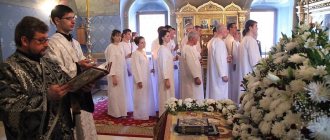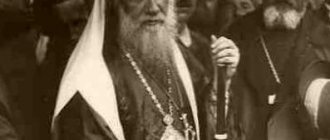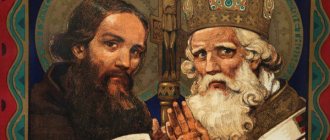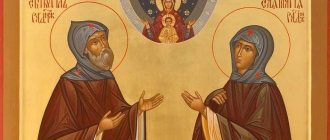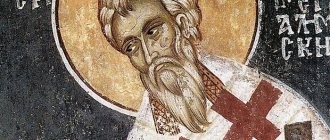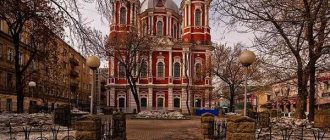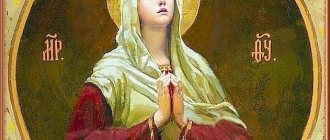Brief Life of Equal-to-the-Apostles Cyril
Saint Equal to the Apostles Cyril, the Slovenian teacher (before the adoption of the schema - Constantine) and his elder brother Methodius (April 6) were Slavic in origin, born in Macedonia, in the city of Thessaloniki. Saint Cyril received an excellent education, growing up with the emperor’s son from the age of 14. He accepted the rank of presbyter early. Upon returning to Constantinople, he served as librarian of the cathedral church and teacher of philosophy. Saint Cyril successfully debated with heretical iconoclasts and with Mohammedans. Seeking solitude, he retired to Mount Olympus to visit his older brother Methodius, but his solitude did not last long. Both brothers were sent in 857 by Emperor Michael on a missionary journey to preach Christianity among the Khazars. On the way, they stopped in Kherson and found there the relics of the Holy Martyr Clement, Pope of Rome. Arriving at the Khozars, the holy brothers talked with them about the Christian faith. Convinced by the preaching of Saint Cyril, the Khozar prince and with him all the people accepted Christianity. The grateful prince wanted to reward the preachers with rich gifts, but they refused this and asked the prince to release all the Greek captives with them to their homeland. Saint Cyril returned to Constantinople with 200 released prisoners.
In 862 the main work of the holy brothers began. At the request of Prince Rostislav, the emperor sent them to Moravia to preach Christianity in the Slavic language. Saints Cyril and Methodius, by revelation of God, compiled the Slavic alphabet and translated the Gospel, the Apostle, the Psalter and many liturgical books into the Slavic language. They introduced worship in the Slavic language. Then the holy brothers were summoned to Rome at the invitation of the Pope of Rome, where Pope Adrian greeted them with great honor, for they brought there the relics of the holy martyr Clement, the Pope of Rome. Sick and weak by nature, Saint Cyril soon fell ill from many labors and, having accepted the schema, died in 869 at the age of 42.
Before his death, he bequeathed to his brother to continue the Christian education of the Slavs. Saint Cyril was buried in the Roman Church of Saint Clement, where the relics of this holy martyr, brought to Italy from Chersonese by Slovenian teachers, rest.
The complete life of Equal-to-the-Apostles Constantine, in the monasticism of Cyril
Holy Equal-to-the-Apostles Constantine (Cyril) was born in the city of Thessaloniki (Thessaloniki) in 827. The parent of Saint Equal-to-the-Apostles Cyril, a noble and rich nobleman named Leo, and his mother Mary lived piously, fulfilling the commandments of God. Constantine - a royal name - was the seventh son. When his mother, upon birth, gave him to a nurse so that she could feed him, he did not want to feed on someone else's milk, but only on his mother's milk.
The city of Thessaloniki was home to a large Slavic population, whose language was familiar to Saint Cyril from childhood. There are suggestions that Saint Cyril was a Slav and is called a Greek in sources due to his membership in the Greek Church. When he was seven years old, Konstantin had a dream and told it to his father and mother in the following words: “The governor, the strategist of our city, gathered all the girls of the city and said to me: “Choose from among them whomever you want to help you and be your peer.” I looked around, looked at them all and noticed one, the most beautiful of all, with a luminous face, decorated with many golden monists and pearls and ornaments; her name was Sophia. I chose her." The parents realized that the Lord was giving the child the Virgin Sophia, i.e. Wisdom, they rejoiced in spirit and with diligence began to teach Constantine not only book reading, but also Godly good morals - spiritual wisdom. “Son,” they said to Constantine in the words of Solomon, “honor the Lord and be strong; keep the commandments and you will live; write the words of God on the tablet of your heart; Nartsy (call.—Ed.) Wisdom be your sister, And understanding (i.e., close, dear ones) create for yourself (Prov. 7: 1-4). Wisdom shines brighter than the sun, and if you have it as your assistant, it will save you from much evil.”
It is known what successes this youth showed in the sciences, especially in the study of the works of St. Gregory the Theologian. He studied Homer, geometry, dialectics and philosophy under the guidance of the logothete drome Theoctistus and the future Patriarch Photius. Even in his youth, Saint Constantine was called the Philosopher. In addition, he studied rhetoric, arithmetic, astronomy, musical art and other secular sciences, and also knew Latin, Syriac and other languages.
Although Saint Constantine was brought up at the royal court, together with the young Emperor Michael, and could have taken a high position, he remembered his Girlfriend, and therefore refused a noble and beautiful bride.
When Saint Constantine was elevated to the priesthood, he was simultaneously appointed librarian at the Church of Hagia Sophia. It was from this chosen one of Sophia that Russian Orthodoxy received its beginning.
The apostolic mission among the Slavs was for St. Cyril the pinnacle of feat, for which he was prepared by the Providence of God and St. Sophia all his life. After accepting the priesthood, Saint Cyril, striving for solitude, did not remain in Constantinople for long: he secretly left and hid in one of the monasteries on the coast of the Golden Horn. Only six months later the emperor managed to find him and persuade him to become a philosophy teacher at the main school in Constantinople. Saint Cyril returned to Constantinople. From the time he entered preaching and public church service, his strict zeal for the establishment of Orthodoxy became evident.
Saint Cyril’s first debate was with the leader of the heretical iconoclasts, Annius. The aged Annius was defeated and put to shame by the young philosopher Saint Cyril.
In 851, Saint Cyril, by order of the emperor, went to the Saracens to prove to them the truth of the Christian teaching about the Holy Trinity. This was the saint's first missionary journey, which he made at the age of 24.
Saint Cyril so skillfully defended the truth of the Orthodox faith and so exposed the falsity of the teachings of Muslims that the Saracen sages, not knowing what to answer him, tried to poison the saint. But the Lord kept His servant unharmed. Upon his return from the Saracens, Saint Cyril renounced the honorary position of teacher of philosophy and settled in a monastery on Olympus, where his elder brother Saint Methodius (815-885, Comm. April 6) labored. Saint Cyril spent several years in monastic deeds, prayer and reading the works of the holy fathers. On Olympus he began to study the Slavic language and became acquainted with Hebrew and Coptic writing.
In 858, ambassadors from the Khazars came to Constantinople with a request to send a learned man to them so that he would expose the lies of the Saracen and Jewish preachers who were trying to convert the Khazars to their faith. Emperor Michael III sent St. Cyril to the Khazars to preach the Gospel. His holy brother Methodius also went with him. Along the way, the holy brothers stopped for some time in the Crimea, in the Greek colony of Chersonesos. There Saint Cyril studied Jewish grammar. At the same time, Saint Cyril became acquainted with the Gospel and Psalter, written in Russian letters.
In Chersonesos, the holy brothers took part in the opening of the relics of the Hieromartyr Clement, Pope of Rome. Taking with them part of the holy relics, they continued their journey.
In the Khazar land, having won a dispute between Jews and Muslims, Saint Cyril converted many to Christianity. Refusing the rich gifts offered by the Khazar Khagan, Saints Cyril and Methodius asked in return to release all Greek captives. At their request, 200 people were released and returned to their homeland. In Constantinople, the holy brothers were greeted with great honors, like apostles. Saint Methodius retired to his monastery, and Saint Cyril settled at the Church of the Holy Apostles and began work on compiling the Slavic alphabet and translating the liturgical books into the Slavic language.
After some time, Saint Cyril and his brother went to preach Christianity in Bulgaria.
In 862 (or 863) ambassadors from the Moravian prince Rostislav came to Constantinople with a request to send Christian teachers. The choice of the emperor fell on Saint Cyril, who by the Providence of God had been prepared by that time for a great mission among the Slavic peoples. Despite his illness, Saint Cyril joyfully took up the task of fulfilling his obedience. Like any business, he began the feat of enlightening the Slavs with prayer, and then imposed a forty-day fast on himself. Soon, God, listening to the prayers of His servants, fulfilled what His faithful servant asked for: Saint Cyril compiled the alphabet for the Slavs (Glagolitic), and then, with the help of his brother and disciples, continued to translate the Greek Holy Books into the Slavic language. The first book translated by Saint Cyril was the Gospel of John. The Followed Psalter (which included the texts of troparia and kontakia for feasts and saints), various texts of the Holy Scriptures and liturgical books were also translated. This glorious feat of St. Cyril was the basis of the great work of introducing the Slavs to the Christian faith and culture. Since then, a new life has come for the Slavs, the possibility of original spiritual development has appeared under the beneficial effect of preaching and worship in their native Slavic language.
St. Cyril's struggle for the independence of the Slavic peoples was complicated by the fact that the work of enlightening the Slavs was begun in Moravia, a country under Roman influence. The German priests who headed the Christian churches in Moravia did their best to prevent the introduction of divine services in the Slavic language, believing that it should be performed only in three languages: Hebrew, Latin or Greek. Saints Cyril and Methodius, exposing their untruths with the words of Holy Scripture, tirelessly prepared the servants of the new Church. Under the leadership of the holy brothers, the Moravian prince Rostislav began the construction of temples and gathered many youths to teach the Slavic alphabet and reading translated books. In a short time, Saint Cyril and his disciples translated the church rites and introduced all Divine services according to the rules. This marked the beginning of the formation of independent Slavic Churches.
But the enemies of the cause of enlightenment of the Slavs continued to hinder them: they denounced Saints Cyril and Methodius to Pope Nicholas I, accusing them of heresy. The Pope summoned the holy brothers to Rome. Taking with them part of the relics of the holy martyr Clement, they set off on a new journey, which was very unfavorable for the health of Saint Cyril. Their path lay through Slavic lands. In Pannonia, at the request of Prince Kocel, they taught him and 50 young men the Slavic alphabet. When parting, the prince wanted to give gifts to the holy preachers. But Saints Cyril and Methodius did not want to take from Kocel, just like from Rostislav of Moravia, neither silver nor gold. They preached the Gospel word free of charge and only asked for freedom from both 900 Greek captives.
In Venice, the brothers made one more stop. There Saint Cyril again had heated debates with the “trilinguals.” He proved the right of every people to their own written language and referred to the Holy Scriptures and the experience of a number of peoples (Armenians, Persians, Georgians, Goths, Avars, Khazars, Arabs, Syrians, etc.) who had their own written language for a long time.
Before the arrival of the saints in Rome, Pope Nicholas I died. The new Pope Adrian II was friendly towards the holy brothers and greeted them solemnly, especially since they were carrying the relics of the holy martyr Clement. Pope Adrian II recognized the Slavic language in the Holy Scriptures and Liturgy, but was in no hurry to release the brothers for further preaching in the Slavic lands.
Exhausted by labor and long travel, Saint Cyril fell seriously ill. During his illness, the Lord revealed to him that death was approaching, and Saint Cyril accepted the schema. He devoted the remaining 50 days of his life to repentant prayer and conversations with his disciples and brother, instructing and teaching them, commanding them to return to the Slavic lands and complete the work they had begun. On February 14, 869, Saint Cyril gave up his soul to God, having lived only 42 years. His body was buried in the Church of St. Clement in Rome. The memory of Equal-to-the-Apostles Cyril is also celebrated on May 11, together with the memory of the holy brother Methodius.
In the iconographic tradition of the ancient Churches, Saint Cyril, Equal to the Apostles, is depicted in hierarchal robes, as for example in the 11th century fresco of the St. Sophia Cathedral in Kiev, or the 9th century fresco in the Church of St. Clement in Rome, which depicts the consecration of Saint Cyril as a bishop. These facts indicate that Saint Cyril was in the rank of bishop.
Literature
- Životy Konštantina-Cyrila a Metoda. In: Encyklopédia Slovenska
. - Moravsko-panónske legendy. In: KNĚZEK, Libor, ed. Encyklopédia literárnych diel
. 1.vyd. Bratislava: Obzor, 1989. 858 s. ISBN 80-215-0010-7. s. 373. - Život Konštantína a Život Metoda in: Pyramída-encyklopedický časopis moderného človeka
, č. 192 - HAVLÍK, Lubomír Emil (ed.). [www.cormierop.cz/Magnae-Moraviae-Fontes-Historici.html Magnae Moraviae fontes historici]
II. 1.vyd. Brno: Universita JE Purkyně v Brně - filosofická fakulta, 1967. s. 57 - 60. - PIŠÚT, Milan, a kol. Dejiny slovenskej literatúry
. 3. dopl. a preprac. vyd. Bratislava: Obzor, 1984. 902 s. - ŠKOVIERA, Andrej, ed. Pramene o živote svätých Cyrila a Metoda a ich učeníkov
. Bratislava: PostScriptum, 2013. 200 s. ISBN 978-80-89567-23-2. - LUKOVINY, Ľuboš. [www.slavu.sav.sk/casopisy/slavica/2008_01/2008_1.pdf Filozofia v 9. storočí (textovo-sémantická analýza Života Konštantína)]. Slavica Slovaka
, 2008, roč. 43, čis. 1, s. 11-28. ISSN 0037-6787
